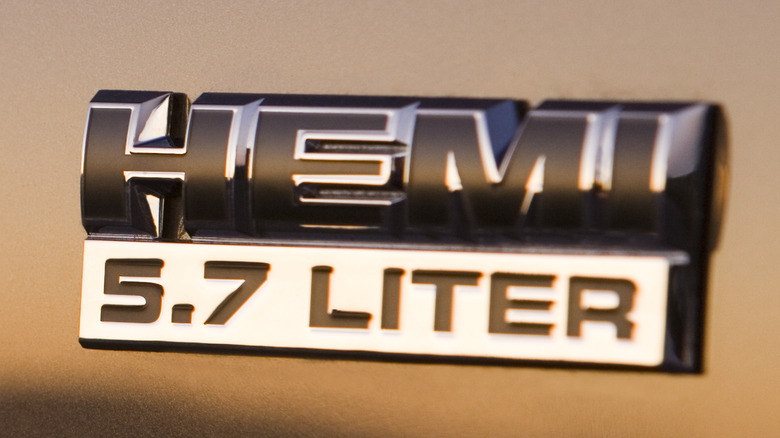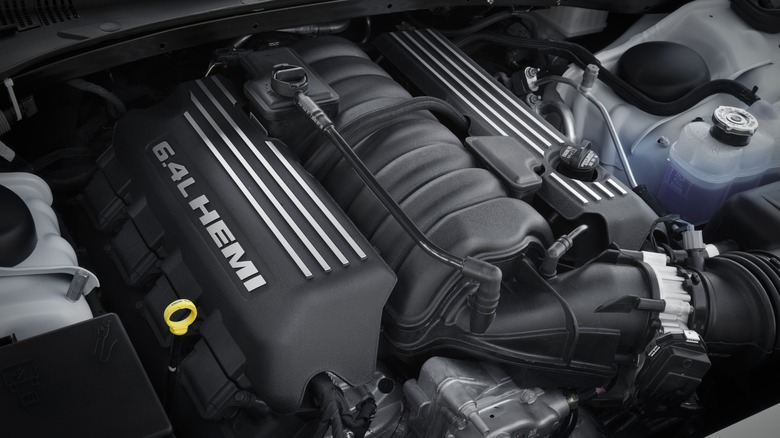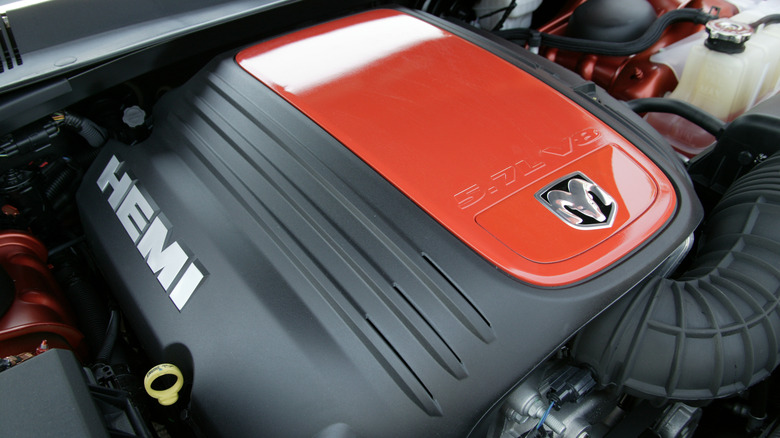Are The HEMI Engines In Dodge Chargers & Challengers The Same As What's In Trucks?
The Chrysler Hemi engine boasts one of the most famous names in muscle car history, powering a diverse array of models that are dripping with character and speed. Dodge, Plymouth, Chrysler, and even Jeep have used Hemi powertrains in their respective lineups, at one point or another. Moreover, with the Hemi's third-generation (commonly called the Gen III Hemi by enthusiasts), the name now appears prominently on a greater number of cars than ever before, presenting one interesting dilemma for Stellantis.
That problem is: how do you make one engine fit into so many different body styles? A vehicle like a Dodge Challenger has different clearances than a truck like a Ram, for example. Put simply, you don't, at least not with a single universal configuration. While the internals of most 5.7L Hemi engines are identical, the truck and car variants feature substantial outer differences, such as exhaust and intake manifolds, oil pans, accessory drives, and more. These differences only exaggerate when you scale up to the 6.4L Hemi.
Of all the different patterns of Hemi, the 6.4L/392 features the most unique differences between the car and truck models, so we'll focus on that. The main variations, again, come from factors like manifold shape due to clearances with AWD systems or lower hood lines. Let's dive into the nuts and bolts and discuss the most dramatic differences and what you need to know.
The biggest variations: 6.4L Hemi
While most Hemi engines exhibit minor discrepancies, and we'll get to those, the 6.4L is unique in that it contains significant differences in both external geometry and internal composition – let's focus on the latter. The biggest change between them is the compression ratio, with trucks featuring a milder 10.0:1 compression ratio compared to the car's 10.9:1, resulting in noticeable power differences. While multiple models use the 6.4L Hemi, trucks have between 366 and 410 horsepower and 429 lb-ft of torque, and the hotter car engines range from 470 to 485 horsepower and torque from 465 to 475 lb-ft.
Much of this likely owes to the truck engine's use of a milder camshaft, designed to produce peak power in a lower and wider RPM band than the cars, specifically between 3100 and 5000 RPM. While camshafts do not directly affect an engine's compression ratio, a broader, milder camshaft modifies the engine's airflow by opening and closing the valvetrain at different times, resulting in a different overall power curve. The net result of this is that you either have a sharper peak horsepower at the top of the RPM band, or a more consistent and torquier but lower horsepower rating in the middle. Being that trucks aren't designed for outright performance, the latter makes more sense when, for instance, you're towing at highway speeds for long distances, as opposed to drag racing.
Aside from this, truck engines have unique cylinder head castings, with their own casting numbers to match, more suited to towing conditions. These unique heads are also used on Challenger Drag Pak engines; everything else is minor, with the aforementioned accessory and manifold differences being the most obvious.
More minor differences with the Gen III in general
Usually you can spot differences based on small power figure discrepancies, which generally indicate, for instance, a smaller-diameter exhaust manifold meant to accommodate a truck's AWD setup. These variations typically don't result in many compatibility issues apart from parts fitment; however, for the most part, a 6.1L is identical between car and truck applications, only featuring a smaller power figure on the Jeep Grand Cherokee SRT8 - 420 horsepower, as opposed to 425 on everything else. Ultimately, there's little reason to produce different variations of the same engine for every single vehicle in a lineup, after all.
However, some models do still feature interesting quirks that make their particular builds unique. Take, for example, the six-speed manual Charger; these models don't feature a Multi-Displacement System (MDS), basically a cylinder deactivator, whereas automatic-equipped variations do. Similarly, because the 5.7L found use in so many models and features two major head patterns (2003-2008 and 2009-2024), it naturally has a host of variations between many different applications, depending on the dimensions of the engine bay. And who knows what'll happen when the new Hemi is released for RAM trucks?
Overall, if you're looking to do a swap or shopping around for spare parts, the biggest factor to know is that the majority of internals are identical between each Hemi, provided the displacement is the same – unless you're talking about the 6.4L. Exterior-wise is a different story, however, because no two models are perfectly similar.


